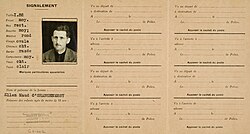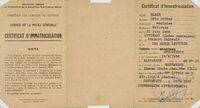National identity card (Morocco)
| Moroccan national identity card البطاقة الوطنية للتعريف ⵜⴽⴰⵕⴹⴰ ⵜⴰⵏⴰⵎⵓⵔⵜ Carte nationale d’identité | |
|---|---|
 | |
 | |
| Type | Electronic identification card |
| Issued by | Sûreté Nationale |
| First issued | 15 February 1977 (law signed) 2020 (new-generation electronic cards) |
| Valid in | Template:Country data Ceuta Template:Country data Melilla |
| Eligibility | Moroccan nationals (mandatory at age 16, optional for minors) |
| Expiration | 10 years |
| Cost | 75 dirham (US$7.35, for adults and minors over age 12) 50 dirham (US$4.90, for minors under age 12) |
The Moroccan national identity card (Arabic: البطاقة الوطنية للتعريف, Template:Lang-zgh, French: carte nationale d’identité; CNI) is the biometric identity document for Moroccan citizens consisting of an electronic ID-1 smart card with identifying information.[1] An immatriculation card (Arabic: بطاقة التسجيل, French: carte d'immatriculation), a variant of the CNI, is issued for foreigners in Morocco for visitors, students, workers, family reunification, and long-term healthcare.[2][3][4] It is issued by the General Directorate of National Security (DGSN) and is compulsory after the age of 16 while being valid for a period of 10 years, but can be obtained at any age.[5][6]
The CNI enjoys a unique position in Moroccan society, and is used in nearly every aspect of transactional life in the country. The CNI has various usages and essentially replaces various documents; birth certificate, certificate of residence, proof of life, and certification of nationality.[7] The DGSN procedurally coordinates with other government departments for proof of identity and confirmation of fingerprints among other uses, such as law enforcement and passports.[7][8] The CNI can be used for border and migration control and as a valid travel document in the Spanish enclaves of Ceuta (for residents of Tétouan) and Melilla (for residents of Nador).[9][8][10]
The new-generation electronic identification (CNIe) system is based upon the MOSIP protocol and is used alongside the Mon Identité Numérique portal developped by the Agency for Digital Development (ADD) for electronic identification and trust services for financial transactions and was first introduced in 2020.[1][11][12] About 20 million active CNI cards have been issued covering 85% of the Moroccan population, about 5,2 million of which are under the new-generation CNIe system.[7][13]
Requirements
The following requirements are needed for issuing a national identity card:[14]
- CNIe pre-application form (if filled out);
- Four recent passport-size photographs, no more than 6 months old, conforming to biometric standards;
- A fee (stamp duty) of 75 dirham for applicants over age 12 and 50 dirham for applicants under age 12;
- Copy of the page of the family booklet regarding the applicant or;
- A full copy of the civil registry regarding the applicant or;
- A birth certificate for the applicant (the last two documents must be valid for no more than three months, and must be written in Arabic and Latin);
- Court order, royal decree, certificate of nationality, or certified copy of the act granting Moroccan nationality (for foreigners or when the applicant's Moroccan nationality appears doubtful);
- Certificate of residence issued by:
- Police services in urban areas or;
- The Royal Gendarmerie for rural areas;
- A certificate of consular registration for Moroccans living abroad;
- To obtain the optional entry "wife" or "widow(er)" on the CNI card:
- a certified copy of the marriage certificate;
- birth certificate of spouse;
- spouse's death certificate;
- For minor applicants, the minor's presence is mandatory alongside their legal guardian, who must present a copy of their CNI and proof of their status;
History
A national identity program existed in Morocco since the late 1970s, the Moroccan national identity card was instituted as n° 1-73-560 and signed by King Hassan II on 15 February 1977 following a meeting with the Council of Ministers on 13 March 1975.[7][15] A semi-electronic identity system was introduced in 1996 with a paper fingerprint system.[9]
In 2008, a fully-electronic identification system (CNIe) was introduced with an automated fingerprint system in a partnership between the DGSN and the French Thales Group.[8][7] The CNIe was a smart card with a barcode and RFID support.[9][8] In 2020, a new CNIe system was implemented in a partnership between the DGSN, the ADD and IDEMIA.[16]
Technology
The National Identity Registry is a foundational national identity system implemented alongside the card and is one of the only registries in the country which implements biometrics, making it one of the most robust in the country.[7]
The registry registers fingerprints using a non-standard method, with 4 fingers captured flat on live scan for verifying duplicates and for quick checks, while 10 fingers captured rolled with ink then scanned for offline validation, all fingerprints are then registered on an automated fingerprint identification system (AFIS).[7] It is unclear why the unorthodox method was chosen, but the World Bank suggests that a 10 fingers rolled printed format were requested by judicial autorities.[7]
| positions | length | chars | meaning |
|---|---|---|---|
| 1-3 | 1-3 | alpha | Region code where the card was first issued |
| 4-10 | 6 | num | Sequential serial number |
| 11-12 | 2 | num | Luhn control number |
| code | region |
|---|---|
| A, AA, AC, AJ | Rabat |
| AB, AE, AY, AS | Salé |
| AD | Témara |
| B, BA, BB, BE, BH, BJ, BK, BL, BM, BF, BV, BW | Casablanca |
| BX, DF, PK, PP, PS | Moroccans residing abroad (MRE) |
| C, CC, CD | Fez |
| CB | Sefrou |
| CN | Boulemane |
| D, DN | Meknes |
| DA | Azrou |
| DB | Ifrane |
| DC | Moulay Idriss Zerhoun |
| DJ | Ain Taoujdate |
| DN | El Hajeb |
| DO | Ouislane |
| E, EE | Marrakesh |
| EA | Ben Guerir |
| F | Oujda |
| FA | Berkane |
| FB | Taourirt |
| FC | El Aioun Sidi Mellouk |
| FD | Ain Bni Mathar |
| FE | Saïdia |
| FG | Figuig |
| FH | Jerada |
| FJ | Ahfir |
| FK | Touissit |
| FL | Bouarfa |
| G | Kenitra, Sidi Yahya El Gharb |
| GA | Sidi Slimane, Sidi Yahya El Gharb |
| GB | Souk El Arbaa |
| GK | Sidi Kacem |
| GM | Ouazzane |
| GN | Mechra Bel Ksiri |
| GJ | Jorf El Melha |
| H, HH | Safi |
| HA | Youssoufia |
| I | Beni Mellal |
| IA | Kasba Tadla |
| IB | Fquih Ben Saleh |
| IC | Azilal |
| ID | Souk Sebt Ould Nemma |
| IE | Demnate |
| J, JK | Agadir |
| JA | Guelmim |
| JB | Inezgane, Dcheira El Jihadia |
| JC | Taroudant |
| JD | Sidi Ifni |
| JE | Tiznit |
| JF | Tan-Tan |
| JH | Chtouka Aït Baha |
| JM | Aït Melloul, Temsia, Lqliâa, Oulad Dahou |
| JT | Oulad Teima |
| JY | Tata |
| JZ | Assa-Zag |
| K, KB | Tangier |
| KA | Asilah |
| L | Tétouan |
| LA | Larache |
| LB | Ksar el-Kebir |
| LC | Chefchaouen |
| LE | Martil |
| LF | Fnideq |
| LG | M'diq |
| M | El Jadida |
| MA | Azemmour |
| MC | Sidi Bennour |
| MD | Zemamra |
| N | Essaouira |
| O, OD | Dakhla |
| P | Ouarzazate |
| PA | Tinghir |
| PB | Zagora |
| Q | Khouribga |
| QA | Oued Zem |
| R | Al Hoceima |
| RB | Imzouren |
| RC | Targuist |
| RX | Bni Bouayach |
| S, SA | Nador |
| SH | Laayoune |
| SJ | Smara |
| SK | Tarfaya |
| SL | Boujdour |
| T | Mohammedia |
| TA, TK | Benslimane |
| U | Errachida |
| UA | Goulmima |
| UB | Er-Rich |
| UC | Erfoud |
| UD | Rissani |
| V | Khenifra |
| VA | Midelt, Itzer |
| VM | M'rirt |
| W | Settat |
| WA | Berrechid |
| WB | Ben Ahmed |
| X | Khemisset |
| XA | Tifelt |
| Y | Kalaat Sraghna |
| Z | Taza |
| ZG | Guercif |
| ZH | Karia Ba Mohamed |
| ZT | Taounate |
References
- ↑ 1.0 1.1 Borak, Masha (2023-06-22). "Morocco will introduce digital IDs into health services" (in en-US). https://www.biometricupdate.com/202306/morocco-will-introduce-digital-ids-into-health-services.
- ↑ "DGSN: Les titres de séjour des étrangers de plus en plus sécurisés" (in fr-FR). 2020-10-30. https://aujourdhui.ma/societe/dgsn-les-titres-de-sejour-des-etrangers-de-plus-en-plus-securises.
- ↑ "La DGSN lance une nouvelle génération des titres de séjour des étrangers résidant au Maroc". https://www.challenge.ma/la-dgsn-lance-une-nouvelle-generation-des-titres-de-sejour-des-etrangers-residant-au-maroc-163611/.
- ↑ "Guide pratique pour faciliter votre intégration au Maroc" (in fr-FR). 2018-04-12. https://marocainsdumonde.gov.ma/guide-pratique-pour-faciliter-votre-integration-au-maroc/.
- ↑ "Délivrance de la CNIE pour la première fois" (in fr). https://www.consulat.ma/fr/delivrance-de-la-cnie-pour-la-premiere-fois.
- ↑ "F.A.Q". Direction Générale de la Sûreté Nationale. https://www.cnie.ma/static/faq.
- ↑ 7.0 7.1 7.2 7.3 7.4 7.5 7.6 7.7 7.8 Atick, Joseph J.; Palacios, Robert J.; Angel-Urdinola, Diego; Chen, Dorothée; El Kadiri El Yamani, Fatima; Pino, Ariel (2014-07-01). "Identification for Development (ID4D) country diagnostic : Morocco" (in en). https://documents.worldbank.org/en/publication/documents-reports/documentdetail/363901472492458796/Identification-for-Development-ID4D-country-diagnostic-Morocco.
- ↑ 8.0 8.1 8.2 8.3 "Morocco issues biometric ID cards" (in en). https://www.cnet.com/science/morocco-issues-biometric-id-cards/.
- ↑ 9.0 9.1 9.2 "Review of National Identity Programs in Developing Countries" (in en). https://epar.evans.uw.edu/research/review-national-identity-programs-developing-countries.
- ↑ González, Miguel; Peregil, Francisco (2021-06-10). "España baraja pedir visado a todos los marroquíes para entrar en Ceuta y Melilla" (in es). https://elpais.com/espana/2021-06-10/espana-baraja-pedir-visado-a-todos-los-marroquies-para-entrar-en-ceuta-y-melilla.html.
- ↑ "Identité numérique au Maroc: mode d'emploi" (in fr). 7 December 2022. https://lematin.ma/express/2022/identite-numerique-maroc-mode-demploi/384084.html.
- ↑ "The Kingdom of Morocco introduces a national digital ID program, a case study". https://www.idemia.com/wp-content/uploads/2022/06/idemia-national-digital-id-program-kingdom-morocco-case-study-202206.pdf.
- ↑ "Plus de 5,2 millions de CNIE nouvelle génération en 2021 Pari réussi pour la DGSN." (in fr-FR). 2021-12-20. https://aujourdhui.ma/actualite/plus-de-52-millions-de-cnie-nouvelle-generation-en-2021-pari-reussi-pour-la-dgsn.
- ↑ "Procédures". Direction Générale de la Sûreté Nationale. https://www.cnie.ma/static/procedure.
- ↑ "Dahir portant loi n° 1-73-560 du 25 safar 1397 (15 février 1977) instituant la carte d'identité nationale". Bulletin Officiel du Royaume du Maroc (3362): 3–4. 1977-04-05. http://www.sgg.gov.ma/BO/bo_fr/1977/bo_3362_fr.pdf#page=4.
- ↑ "Identité numérique au Royaume du Maroc" (in fr). 2022-05-19. https://www.idemia.com/fr/actualite/le-royaume-du-maroc-lance-une-plateforme-nationale-didentite-numerique-avec-idemia-2022-05-19.
- ↑ "أحرف و أرقام بطاقة التعريف الوطنية المغربية حسب المدن" (in ar). https://www.moualimi.com/2016/05/Carte-d-identite-nationale-par-villes.html.
- ↑ تحديث, Watiqati Maroc اخر (2021-12-21). "معرفة المدينة بمجرد الإطلاع على رمز أو كود بطاقة التعريف الوطنية" (in ar). https://www.watiqati.ma/2021/08/CIN-VILLE.html.
 |



